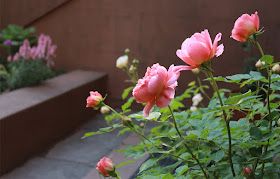There is rarely watercraft action on the great, green, greasy Gowanus. But when I crossed the 3rd Street Bridge the other day, the EPA (Environmental Protection Agency, for non-Americans) was puttering along on the slick water -
one of the most toxic waterways in the country. Despite that fact, and in anticipation of a
Superfund cleanup, the banks of the Gowanus are being beadazzled heavily by developers, and vast lofts are rising in open lots.
Which led to this very funny subway ad by Streeteasy, a user-friendly real estate website that lets you refine your apartment search by applying filters: neighborhood, size, amenities, rent, etc.
On the other side of the bridge is Wholefoods. And its canal-edge garden of mostly indigenous plants.
For full sun, this is a wonderful shrub:
Aronia arbutifolia, red chokeberry. The flowers are prolific and the fruit that ripens late in the year is tart but very good in cordials, sauces and jams.
Pick the fruit after the mouth-puckering tannins have dissipated. Google Aronia and you'll find hysterical antioxidant claims on its behalf, in pill form. The fruit is much more fun.
Redbuds (Cercis canadensis) had a very good spring, this year. They are an understorey tree in the eastern United States.
And there is bayberry (
Myrica pensylvania), which is typically a shoreline shrub with very aromatic leaves.
Gowanus still has the grit whose loss in some neighborhoods many people mourn; under the bridge in a homeless man's encampment was an open suitcase, still neatly packed. A silent question mark.
I'll be leading two other Brooklyn walks, soon: one around the distinctly gritty
Dead Horse Bay, on May 7th, where weeds, edible indigenous plants, low-tide bottle scavenging and our picnic will compete for attention.
The next is in the non-gritty and very plant-saturated Brooklyn Bridge Park, on behalf of the BBP Conservancy. That's May 11th and is in the early evening, from 6.30pm - 7.30pm. The Conservancy underwrites the walk and
the tickets are just $10. If I were you I'd follow it with a chaser of dinner at Vinegar Hill House, in Dumbo.
_________________________




















































